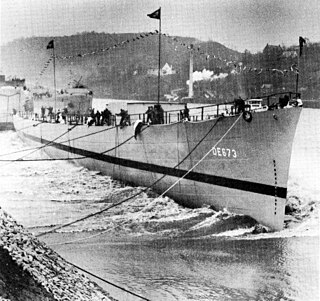
USS Gosselin (APD-126) was a Crosley-class high speed transport of the United States Navy, in service from 1944 to 1949. She was sold for scrap in 1965.

USS Balduck (APD-132) was a Crosley-class high speed transport of the United States Navy, named after Marine Corporal Remi A. Balduck (1918–1942), who was killed during the Battle of Guadalcanal. For his actions he was posthumously awarded the Navy Cross.

USS Numitor (ARL-17) was to be laid down as an LST-542-class tank landing ship but was instead laid down as one of 39 Achelous-class repair ships landing craft repair ships built for the United States Navy during World War II. Named for Numitor, she was the only US Naval vessel to bear the name.

USS Myrmidon (ARL-16) was laid down as a United States Navy LST-542-class tank landing ship but converted to one of 39 Achelous-class repair ships that were used for repairing landing craft during World War II. Named for the Myrmidons, she was the only US Naval vessel to bear the name.

USS LST-19 was a United States Navy LST-1-class tank landing ship used exclusively in the Asiatic-Pacific Theater during World War II and manned by a United States Coast Guard crew. Like many of her class, she was not named and is properly referred to by her hull designation.

USS Wantuck (APD-125) was a United States Navy high-speed transport in commission from 1944 to 1957.

USS Kinzer (APD-91), ex-DE-232, was a United States Navy high-speed transport in commission from 1944 to 1946.

USS Brock (APD-93), ex-DE-234, was a United States Navy high-speed transport in commission from 1945 to 1947.

USS William M. Hobby (APD-95), ex-DE-236, was a United States Navy high-speed transport in commission from 1945 to 1946.

USS Ray K. Edwards (APD-96), ex-DE-237, was a United States Navy high-speed transport in commission from 1945 to 1946.

USS Knudson (APD-101), ex-DE-591, later LPR-101, was a United States Navy high-speed transport in commission from 1944 to 1946 and from 1953 to 1958.

USS Rednour (APD-102) was a Crosley-class high speed transport that served in the United States Navy from 1945 to 1946. In December 1969, she was transferred to Mexico and served as Chihuahua until July 2001.

USS William J. Pattison (APD-104), ex-DE-594, was a United States Navy high-speed transport in commission from 1945 to 1946.

USS Earle B. Hall (APD-107), ex-DE-597, was a United States Navy high-speed transport in commission from 1945 to 1946, 1950 to 1957 and 1961 to 1965.

USS Kline (APD-120) was a Crosley-class high-speed transport in commission with the United States Navy from 1944 to 1947. She was transferred to the Republic of China Navy in 1966 and served as ROCS Shou Shan (PF-37/PF-893/PF-837) until 1997. She was finally sunk as a target in 2000.

USS John P. Gray (APD-74), ex-DE-673, was a United States Navy high-speed transport in commission from 1944 to 1946.

USS Jack C. Robinson (APD-72), ex-DE-671, was a United States Navy high-speed transport in commission from 1945 to 1946.

USS Pavlic (APD-70) was built by Dravo Corporation at Pittsburgh, Pennsylvania as a Buckley-class destroyer escort. Pavlic was launched 18 December 1943 and towed to Texas for refitting as a United States Navy high-speed transport. Pavlic was in commission from 1944 to 1946, serving in the Okinawa campaign as a radar picket ship. Pavlic was decommissioned 15 November 1946. After more than 20 years of inactivity in reserve, she was stricken from the Navy List on 1 April 1967. On 1 July 1968, she was sold for scrapping to North American Smelting Company.

USS LST-20 was a United States Navy LST-1-class tank landing ship used exclusively in the Asiatic-Pacific Theater during World War II and manned by a United States Coast Guard crew. Like many of her class, she was not named and is properly referred to by her hull designation.

USS LST-24 was a United States Navy LST-1-class tank landing ship used exclusively in the Asiatic-Pacific Theater during World War II and manned by a United States Coast Guard crew. Like many of her class, she was not named and is properly referred to by her hull designation.




















